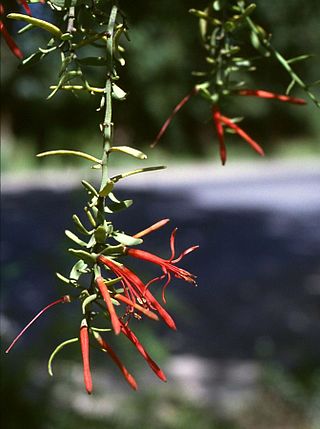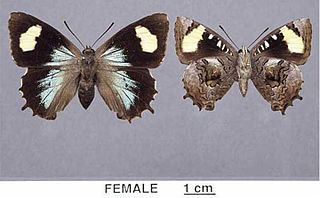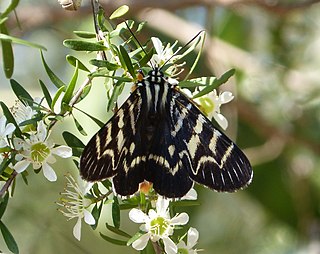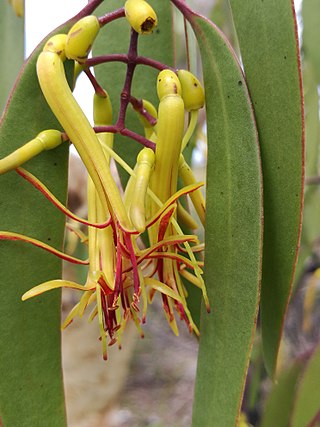Jezebel was a biblical figure, the wife of King Ahab.

Loranthaceae, commonly known as the showy mistletoes, is a family of flowering plants. It consists of about 75 genera and 1,000 species of woody plants, many of them hemiparasites. The three terrestrial species are Nuytsia floribunda, Atkinsonia ligustrina, and Gaiadendron punctatum Loranthaceae are primarily xylem parasites, but their haustoria may sometimes tap the phloem, while Tristerix aphyllus is almost holoparasitic. For a more complete description of the Australian Loranthaceae, see Flora of Australia onlineArchived 2018-04-01 at the Wayback Machine., for the Malesian Loranthaceae see Flora of Malesia.

Delias eucharis, the common Jezebel, is a medium-sized pierid butterfly found in many areas of south and southeast Asia, especially in the non-arid regions of India, Bangladesh, Sri Lanka, Indonesia, Myanmar and Thailand. The common Jezebel is one of the most common of the approximately 225 described species in the genus Delias.

Delias pasithoe, the redbase Jezebel is a medium-sized butterfly of the family Pieridae, that is, the yellows and whites. The species is found in parts of South Asia and Southeast Asia. There has been some dispute for which species the specific name aglaja, used twice by Linnaeus in 1758, applies – the redbase Jezebel, or the dark green fritillary, a brush-footed butterfly. Here, Delias pasithoe is used for the redbase Jezebel, based on the replacement name proposed by Linnaeus himself.

Amyema is a genus of semi-parasitic shrubs (mistletoes) which occur in Malesia and Australia.

Delias argenthona, the scarlet Jezebel or northern Jezebel, is a medium-sized butterfly of the family Pieridae found in Australia and New Guinea. Its caterpillars feed on showy mistletoes, family Loranthaceae.

Delias harpalyce, the imperial white, is a butterfly in the family Pieridae. It is endemic to Australia.

Delias mysis, the Union Jack or red-banded Jezebel, is a butterfly in the family Pieridae. It is endemic to northern Australia, New Guinea and neighbouring islands. The common name is a reference to the flag of the British Empire. The butterfly was given this name, because the patterns and colours on the underside of the wings of the males resembles the flag.

Delias aganippe, the wood white or red-spotted Jezebel, is a butterfly in the family Pieridae.

Delias nysa, common name yellow-spotted jezebel, is a butterfly in the family Pieridae, described in 1775. It is found in Australia, New Caledonia and Vanuatu. The wingspan is 50 mm.

Dendrophthoe vitellina, commonly known as long-flowered- or apostle mistletoe, is a hemiparasitic plant of the mistletoe family Loranthaceae. The genus Dendrophthoe comprises about 31 species spread across tropical Africa, Asia, and Australia. Despite being collected by Joseph Banks and Daniel Solander in 1788, and depicted in Banks' Florilegium, it was not until 1860 that it was described by Ferdinand von Mueller as Loranthus vitellinus after being collected near Ipswich, and renamed by Philippe Édouard Léon Van Tieghem in 1895.

Ogyris ianthis, commonly known as the golden azure or Sydney azure, is a butterfly of the family Lycaenidae. It is an uncommon species found in localised areas around Sydney and northern New South Wales and into southern Queensland. It inhabits dry sclerophyll forest and open woodland on sandstone soils.

Ogyris genoveva, the genoveva azure or southern purple azure, is a butterfly of the family Lycaenidae. It is found in Australia.

Comocrus is a monotypic moth genus in the family Noctuidae erected by Karl Jordan in 1896. Its only species, Comocrus behri, the mistletoe moth or mistletoe day moth, was first described by George French Angas in 1847. It is widely distributed in southern Australia from Perth to Melbourne and adjacent to Bass Strait, occurring as far north as Derby, Western Australia, and Clermont and Rockhampton in Queensland. It may be seen during daylight hours hovering around mistletoe species such as Amyema miquelii, Amyema melaleucae and Amyema cambadgei growing on Casuarina and Eucalyptus trees. The adult moths feed on Eucalyptus flower nectar, have a wingspan of some 58 millimetres and are basically black with white bands running through the wings. Individuals ready to mate exhibit 'hill-topping' behaviour, flying to high points in the landscape and there encountering mates.

Muellerina is a genus of parasitic aerial shrubs in the family Loranthaceae.

Muellerina eucalyptoides, commonly known as creeping mistletoe, is a hemiparasitic aerial shrub in the family Loranthaceae. The species is endemic to Australia.

Amyema sanguinea is an aerial hemiparasitic shrub within the genus Amyema, in the family Loranthaceae and native to Australia, where it is found in New South Wales, Queensland, the Northern Territory, South Australia and Western Australia.

Muellerina celastroides, common names Banksia mistletoe and coast mistletoe, is a hemiparasitic aerial shrub in the family Loranthaceae. The species is endemic to New South Wales, Victoria and Queensland.





















